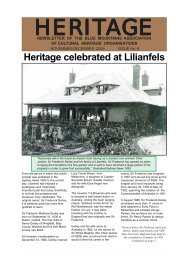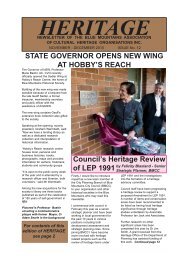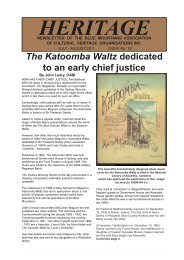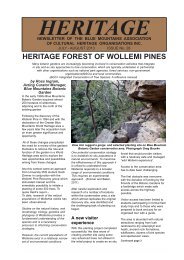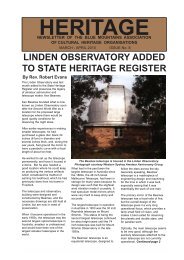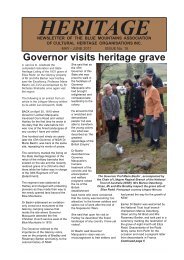Blue Mountains History Journal Issue 2
Blue Mountains History Journal Issue 2
Blue Mountains History Journal Issue 2
You also want an ePaper? Increase the reach of your titles
YUMPU automatically turns print PDFs into web optimized ePapers that Google loves.
<strong>Blue</strong> <strong>Mountains</strong> <strong>History</strong> <strong>Journal</strong> 2; 2011<br />
Figure 5. Driving bullock outside The Post Office in Beowang before the telephone was installed in<br />
1916 (MW&MIHS, Shaw Collection, photo 95/125; Field 1995)<br />
In 1913 Mrs. Eliza Sharp asked for a rise in salary as<br />
“ ... business in the summer months is very brisk and I do not consider £17 pounds per annum<br />
sufficient”<br />
She was told that she was receiving more than she was entitled to, yet again in 1915 Sharp renewed<br />
her request, arguing that the proposed installation of the telephone entitled her to an increase and she<br />
could not continue under the same conditions (Sharp 1915). The reply from the Accident Branch on<br />
2 July 1915 (GPO Accounts Branch 1915) was:<br />
“Consideration for telephone duties cannot be given until the date of establishment”.<br />
But the Post Office was not going to be the first place in Mt. Wilson to have a telephone!<br />
The arrival of the Telephone c.1912<br />
Henry Marcus Clark (Figure 6), the well-known Sydney<br />
Retailer, had purchased a number of portions of land in Mt.<br />
Wilson c.1910-1912 including Beowang. However for his<br />
residence he built Sefton Hall (Figure 7) where Balangra (the<br />
home of James Dalrymple Cox, the brother of George Henry<br />
Cox) had stood, the original building having been moved in<br />
two parts one of which became a Billiard Room and the other<br />
was later called Sefton Cottage. Significantly, Henry Marcus<br />
Clark pioneered the introduction of the telephone to Mt.<br />
Wilson by having a line laid from Mt. Victoria to Sefton Hall<br />
c.1912;<br />
“... the necessary poles were then only in situ as far as Bell,<br />
his initial outlay ... was substantial” (Currey 1968, p.93).<br />
It is interesting to note that not all of the residents of Mt.<br />
Wilson were keen to have this advanced technology, fearing<br />
that it would detract from the peace and tranquillity of life in<br />
the village and would result in intrusion and disturbance. In<br />
1913 Clark died at Sefton Hall from complications following<br />
surgery carried out on the premises (pers. comm. Miss Marcia<br />
Figure 6. Henry Marcus Clark 1859- Clark; MW&MIHS 19??a).<br />
1913 (MW&MIHS, Settlement<br />
Collection, photo 98/380).<br />
43 Back to Contents




